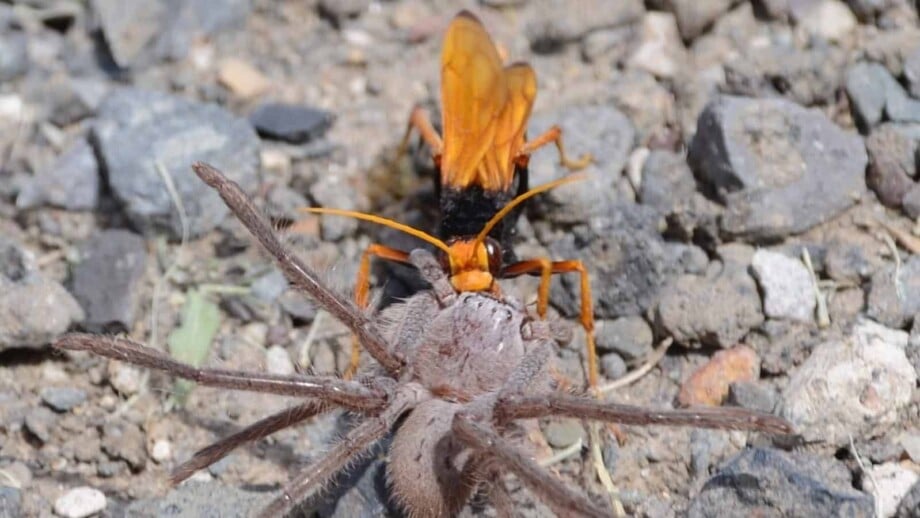Tarantula hawk wasps can be a scary sight for any homeowner or gardener. These wasps can grow up to two inches long, with bodies that are black or dark blue in color, and wings that are iridescent blue or black.
The tarantula hawk wasp is a solitary insect that preys on tarantulas. The female wasp will seek out a tarantula, sting it, and lay an egg on its body. The wasp larva will then feed on the paralyzed tarantula as it grows and develops. This may seem cruel, but it is a necessary part of the ecosystem, as it helps to control the population of tarantulas.
They’re known for their bright orange wings that are visible when they are soaring through the air. Interestingly, the sting of the tarantula hawk wasp is one of the most painful insect stings in the world.
The pain has been described as similar to an electric shock and can last for several minutes. However, the sting is not typically fatal to humans, unless the person has an allergic reaction.
Despite their fearsome reputation, tarantula hawk wasps are actually quite docile and will only sting if provoked or threatened. They are also known for their impressive flying abilities, with some species able to fly at speeds of up to 20 miles per hour.
In this article, I’ll cover everything you need to know about identifying and controlling tarantula hawk wasps.

What is a Tarantula Hawk?
A tarantula hawk is a type of solitary wasp that preys on tarantulas. They are primarily found in the southwestern United States, ranging from California to Texas. These wasps get their name from their hunting behavior, as they hunt tarantulas and use them as a host for their eggs.
The female tarantula hawk will paralyze the tarantula by stinging it, then lay eggs inside the spider’s body. Once the eggs hatch, the larvae will eat the tarantula from the inside out.

Lifecycle of a Tarantula Hawk
The lifecycle of a tarantula hawk begins when the female wasp lays a single egg on the spider’s body. Once the egg hatches, the larvae will feed on the tarantula’s blood and tissue while avoiding vital organs to keep the spider alive until they are fully grown.
The adult wasp will emerge from the tarantula’s body, and the cycle will start again. Tarantula hawks typically have a lifespan of about one year. Adult tarantula hawks get their nutrition from nectar, but females will attack spiders to get their offspring the food they need.
Female tarantula hawks are known for their impressive hunting skills. They are able to locate tarantulas by detecting their pheromones and vibrations. Once a tarantula hawk has found a tarantula, it will use its long, curved sting to inject venom to quickly deliver a paralyzing sting.
The tarantula hawk will then be held captive in its own burrow or get dragged to the wasps’ nest, where it will lay its eggs inside the spider’s body.
Despite their fearsome reputation, tarantula hawks are not aggressive towards humans. In fact, they are known for their docile nature and are unlikely to sting unless provoked. However, their sting is considered to be one of the most painful in the insect world, and can cause intense, long-lasting pain.
There are several species of tarantula hawk, each with their own unique characteristics. For example, the western tarantula hawk (Pepsis formosa) is one of the largest species of wasp in North America, with a wingspan of up to 3 inches. The female western tarantula hawk is known for its bright, iridescent blue wings.
Despite their gruesome hunting habits, tarantula hawks play an important role in their ecosystem. By preying on tarantulas, they help to control their populations and maintain a healthy balance in the ecosystem.

What Do Tarantula Hawk Wasps Look Like?
Tarantula hawk wasps are fascinating creatures that are known for their large size and intimidating appearance. These wasps can grow up to two inches long, making them one of the largest wasp species in the world. Their bodies are typically black or dark blue in color, which provides them with excellent camouflage in their natural habitats.
The wings of the tarantula hawk are iridescent blue or black, which adds to their striking appearance. Their wings are incredibly strong and allow the wasp to fly at high speeds and for long distances. The legs of the tarantula hawk are also quite long and spindly, which helps them to move quickly and efficiently through their environment.
One of the most notable features of the tarantula hawk is its bright orange wings. These wings are a distinctive characteristic of the species, and they help to make the wasp easily recognizable. The orange coloration of the wings is thought to serve as a warning to potential predators, as it indicates that the wasp is venomous and dangerous.
The males of the species have longer antennae than the females. This is a common trait among many species of insects, and it is thought to help the males locate females for mating purposes. The longer antennae allow the males to detect pheromones that are released by the females, which helps them to locate potential mates more easily.

Signs of Tarantula Hawk Wasps
Tarantula hawk wasps are fascinating creatures that are native to the southwestern United States and Mexico. These wasps are known for their bright orange wings and their ability to take down tarantulas, one of the largest spiders in the world. While they are not typically visible in large numbers, there are a few signs that you can look out for if you want to spot a tarantula hawk wasp.
One of the most obvious signs of a tarantula hawk wasp is the bright orange color of their wings. These wasps are often solitary creatures, so if you see a large, solitary wasp flying around with bright orange wings, it is likely a tarantula hawk. They are most active during the daytime and can often be seen flying around gardens or other areas where tarantulas are present.
Another sign of a tarantula hawk wasp is the presence of tarantula burrows. These wasps are known for their ability to locate tarantula burrows and then dig down to find the spider. If you see a wasp digging in the ground near a tarantula burrow, it is likely a tarantula hawk.
Interestingly, tarantula hawk wasps are not aggressive towards humans unless they are provoked. In fact, they are often considered to be beneficial insects because they help to control the tarantula population. However, if you do happen to come across a tarantula hawk wasp, it is best to keep your distance and avoid disturbing it.

What Damage Do Tarantula Hawks Cause?
These wasps are not harmful to humans unless provoked, but their sting is excruciatingly painful. The tarantula hawk wasp is a solitary hunter that preys on tarantulas. The female wasp will search for a tarantula and, once she finds one, will sting it with her venom.
The venom of the tarantula hawk is designed to paralyze the tarantula, allowing the wasp to drag it to a burrow. The wasp will lay her eggs on the tarantula, and when the eggs hatch, the larvae will feed on the paralyzed spider.
While the sting of the tarantula hawk is not lethal to humans, it can cause symptoms that can last for days. The venom of the tarantula hawk can also cause paralysis, which can be dangerous for individuals with certain medical conditions.
Interestingly, the tarantula hawk wasp is not affected by the venom of the tarantula. The wasp has developed an immunity to the spider’s venom, which allows it to hunt and feed on tarantulas without being harmed.
Despite their fearsome reputation, tarantula hawk wasps play an important role in the ecosystem. They help to control the population of tarantulas, which can be beneficial for other species that live in the same habitat.

How to Prevent Tarantula Hawk From Coming Into Your Home
Preventing tarantula hawk wasps from entering your home is not only essential for your safety but also for the safety of your family and pets. Tarantula hawk wasps are known for their painful stings, which can cause severe pain, swelling, and even allergic reactions in some people.
Seal Cracks and Crevices
The first step to preventing tarantula hawk wasps from entering your home is to identify any potential entry points. These can include cracks or gaps in your home’s exterior, as well as open windows and doors. Once you have identified these areas, you can begin to take steps to seal them up and prevent entry.
One way to seal up any cracks or gaps in your home’s exterior is to use caulk or foam insulation. This can be applied to any areas where you suspect tarantula hawk wasps may be entering, such as around windows, doors, and vents.
It’s important to make sure that these areas are completely sealed off, as even the smallest gaps can provide an entry point for these wasps.
Install Window and Door Screens
Another way to prevent tarantula hawk wasps from entering your home is to install screens on your windows and doors. These screens can be made from a variety of materials, including metal, fiberglass, and even nylon.
They should be tightly fitted and securely attached to your windows and doors to prevent any wasps from getting in.
Remove Food Sources
It’s also important to keep your home clean and free of any potential food sources for tarantula hawk wasps. These can include pet food, garbage, and even fallen fruit from trees. By keeping your home free of these attractants, you can help to deter tarantula hawk wasps from coming inside.
Preventing tarantula hawk wasps from entering your home requires a combination of sealing up any potential entry points, installing screens on your windows and doors, and keeping your home clean and free of attractants.
By taking these steps, you can help to ensure the safety of your family and pets and avoid the painful sting of a tarantula hawk wasp.
How to Get Rid of Tarantula Hawks with Different Methods
Tarantula hawks are large and scary wasps that can cause a lot of discomfort and pain if they sting you. If you have spotted these wasps around your property, it’s important to take action to get rid of them before they become a bigger problem.
Fortunately, there are several methods you can use to get rid of tarantula hawk wasps.
Commercial Wasp Spray
One of the easiest and most effective methods to get rid of tarantula hawks is to use a commercial wasp spray. These sprays are readily available at most hardware stores and are designed to kill wasps on contact.
When using a commercial wasp spray, it’s important to follow the instructions carefully and wear protective clothing to avoid getting stung.
Homemade Traps
If you prefer a more natural approach to pest control, you can make homemade traps to catch tarantula hawks. One effective trap is to mix sugar and water in a jar and place it outside.
The sweet scent will attract the wasps, and they will drown in the liquid. You can also use meat as bait in a similar trap to attract and catch the wasps.
Professional Exterminator
If you are not comfortable using chemical or physical methods to get rid of tarantula hawks, you can hire a professional exterminator to do it for you.
Exterminators have the knowledge and equipment to safely and effectively remove wasp nests from your property. They can also provide advice on how to prevent future infestations.
It’s important to remember that tarantula hawks are beneficial insects that play an important role in the ecosystem. They help control populations of other insects and are important pollinators. If possible, try to relocate them to a more suitable habitat rather than killing them.

Tarantula Hawk Wasp vs. Asian Giant Hornet
Although tarantula hawk wasps and Asian giant hornets share some similarities, they are two distinct species. Tarantula hawk wasps are found in the southwestern United States and parts of Mexico. They are known for their bright orange wings and their tendency to prey on tarantulas.
Asian giant hornets, on the other hand, are native to Asia and are the largest hornets in the world. They have a yellow and black striped body and can grow up to three inches in length. They are known for their aggressive behavior and have been responsible for several human deaths in Asia.
Despite their differences, both tarantula hawk wasps and Asian giant hornets play an important role in their respective ecosystems. Tarantula hawk wasps help control the tarantula population, while Asian giant hornets prey on other insects and help pollinate plants.
While tarantula hawk wasps are generally not aggressive towards humans, their sting is considered one of the most painful in the world. It is recommended to avoid disturbing their nests or handling them. If you do get stung, the pain can last for several minutes to several hours.
Asian giant hornets, on the other hand, are known for their aggressive behavior towards humans and should be avoided at all costs. If you encounter an Asian giant hornet, it is recommended to slowly and calmly back away and seek shelter indoors.

Other Wasp Guides from Planet Natural:
Most Common Types of Wasps (And How to Identify Them)
How to Get Rid of Wasps Effectively and Prevent Future Nests











